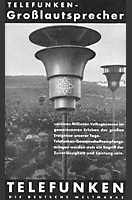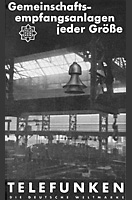Während des dreiwöchigen „Victory Liberty Loan“ in New York City gelingt der Western Electric Company 1919 eine „Spectacular Demonstration of Radiotelephony“ [anonym in: Electrical Review 1919]: Die mit Hilfe der im Krieg entwickelten Funktechnik fernübertragenen Reden (u. a. aus einem Flugzeug), zudem vor Ort per Mikrophon abgenommene Ansprachen sowie Musik werden mittels 112 über der Park Avenue aufgehängter „loud-speaking telephones provided with large horns“ abgestrahlt; „and in this way thousands of people could hear the voice at the same time.“[Secor in: Electrical Experimenter 1920]
„Speeches Through Radiotelephone Inspire New York Crowds“
„DURING the three weeks covering the recent Victory Liberty Loan drive the crowds that daily thronged ‚Liberty Way‘ in New York City were accorded the unusual sensation of having spoken messages come to them out of the air.
The medium that accomplished this modern miracle was the radio telephone that played a considerable part in the war. […]
Having done its bit in winning the war, the radiotelephone was given the task of inspiring the Victory Way crowds to put their dollars into bonds to help pay for victory. It performed its task with great success.
On Victory Way the wireless antennas were stretched over the concourse: 112 loud-speaking telephone receivers were suspended from these antennas in four rows. In front of the speaker’s desk there were three microphone transmitters on iron uprights. This was all the visible evidence of the equipment. But in the nearby Railroad Y. M. C. A. Building there was a maze of wires and switches forming the wireless sending and receiving apparatus. From this point the wireless messages passed over the wires to the control room behind the speaker’s desk on the east side of the enclosure and were there amplified many million times so that they might be heard by the crowds on the concourse through the medium of the loud-speaking receivers. […]
Roughly, the operation of the radiotelephone was as follows: Radio waves received on the antennas passed to the tuning apparatus in the receiving set, by means of which the desired wave lengths are selected and converted into currents of audible frequencies by the detector tube, after which they are amplified about 1500 times and conducted to the telephone control room, where an additional amplification of from one to five million times is provided. The energy is then delivered to the loud-speaking receivers.
The transmitting apparatus consists of a high-frequency oscillator and means for modulating the high-frequency currents in accordance with speech sound waves, which were impressed upon the diaphragm of the telephone transmitter by the speaker’s voice influences. […]
Besides the speakers at Washington, many notables addressed the audiences from the speaker’s stand. Among them were: Mrs. Vincent Astor, Mrs. W. G. McAdoo, Miss Ann Morgan, Admiral Mayo, Rear-Admiral Plunkett, Rear-Admiral Rodman, Brigadier-General Cole; Lieutenant-Colonel Hughes and Martin Vogel. Without the loud-speaking telephone receivers it would not have been possible for a large part of the Victory Way audiences to hear these speakers.
More miraculous, however, were the radiotelephone communications both from the Western Electric Co.’s station on West street and from a navy seaplane flying over New York. From the land sending station, a five-minute speech was transmitted across the city by wireless telephone, received at the antenna over Victory Way, multiplied and transmitted to the loud-speaking receivers, and every word was clearly heard by a crowd of 10,000 people. Music was also transmitted by wireless telephone very effectively.
The demonstration of the speech from a flying plane about a thousand feet above the street seemed the more difficult because the whirring of the propellers would seem to drive out any other sound. In spite of this handicap, which made the hearing of nearby voices difficult, the observer in the seaplane addressed the crowd through his wireless equipment, the radio message being received by the antennas over the concourse and transmitted to the crowd through the loud-speaking receivers. Not only could the crowd understand the flier’s appeal to »Buy Bonds,« but anyone who knew him could even recognize his voice, and when he announced that he would drop a shower of circulars, the crowd waited expectantly until the promised shower appeared.
The flier did not leave for his headquarters until the officials had assured him by wireless telephone that his message had been received and understood by the assembled multitude.“ ([anonym in: Electrical Review 1919, 895f.] zitiert nach: earlyradiohistory.us)

